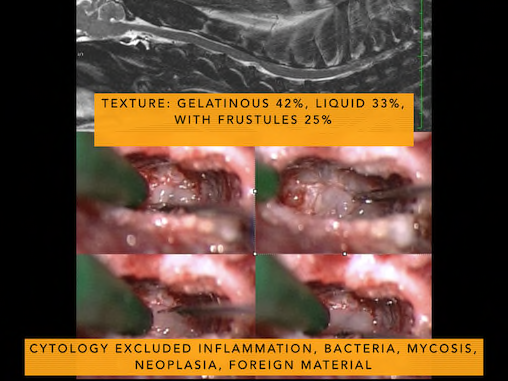Hydrated Nucleus Pulposus Extrusion in dogs: correlation of MRI and microsurgical findings
Acta Veterinaria Scandinavica
accepted Sept 16, 2015
Abstract
Magnetic resonance imaging (MRI) patterns of canine cervical hydrated nucleus pulposus extrusion (HNPE) have been described by a few reports, but the correlation between microsurgical and MRI features has never been investigated. The aim of this study was to compare the MRI features of HNPE with microsurgical findings and cytological outcomes and also to investigate the anatomical and pathophysiological aspects of the disease.
A prospective clinical study was conducted in 36 dogs suffering from HNPE. The diagnosis was based on high field MRI findings of ventral extradural lesions, adjacent to the dorsal aspect of intervertebral discs, characterised by high signal intensity in T2-weighted sequences and hypointensity in T1-weighted sequences. MRI images were analysed with regard to the intervertebral space involved, the grading of spinal cord compression, the signal intensity and distribution of the material, and the thickness and signal intensity of the involved discs. All patients underwent microsurgical decompression and direct observations were recorded and films of the surgical procedure analysed.
The majority of patients had acute onset of clinical signs (78%), the patient did not exhibit signs of pain in 75% of dogs and neurological deficits varied from slight tetraparesis (33%) to tetraplegia (28%). The localization of the extruded disc material was ventral relative to the dorsal longitudinal ligament that was lifted dorsally and appeared intact at the site of compression. Direct microsurgical observations of the HNPE sites showed that extruded disc material was collected within the fibres of the dorsal longitudinal ligament. The consistency was gelatinous in 42%, water-like in 33%, and lumpy liquid in 25% of cases. Cytological samples did not detect the presence of inflammation, bacteria, fungi, neoplastic cells or foreign material.
Microsurgical features of HNPE suggest that the extruded disc is collected within the fibres of the dorsal longitudinal ligament and this may explain the typical MRI appearance of this disease. Further pathophysiological studies are needed to investigate why the cervical nucleus pulposus extrusion appears to occur without obvious trauma.
Dolera M, Malfassi L, Marcarini S, Mazza G, Sala M, Carrara N, Vailati Facchini R, Finesso S.
